Research Trends in the Remote Sensing of Phytoplankton Blooms: Results from Bibliometrics
Abstract
:1. Introduction
2. Data and Methods
2.1. Data
2.2. Analysis Method
3. Results and Discussion
3.1. Variation Characteristics of Total Publications
3.2. Publication Patterns: Subject Categories and Journals
3.3. National Publication Performance and Cooperation
3.4. Research Hotspots and Tendencies
3.4.1. Keyword Analysis
3.4.2. Topic Analysis
3.5. Future Research Directions
3.5.1. Accurate Observation of Phytoplankton Blooms
3.5.2. Traits of Phytoplankton Blooms
3.5.3. Drivers, Early Warning, and Management of Phytoplankton Blooms
3.6. Future Challenges and Opportunities
4. Conclusions
Author Contributions
Funding
Institutional Review Board Statement
Informed Consent Statement
Data Availability Statement
Acknowledgments
Conflicts of Interest
References
- Alvarenga, D.O.; Fiore, M.F.; Varani, A.M. A Metagenomic Approach to Cyanobacterial Genomics. Front. Microbiol. 2017, 8, 809. [Google Scholar] [CrossRef] [PubMed] [Green Version]
- Berdalet, E.; Fleming, L.E.; Gowen, R.; Davidson, K.; Hess, P.; Backer, L.C.; Moore, S.K.; Hoagland, P.; Enevoldsen, H. Marine harmful algal blooms, human health and wellbeing: Challenges and opportunities in the 21st century. J. Mar. Biol. Assoc. UK 2015, 2015, 61–91. [Google Scholar] [CrossRef] [Green Version]
- Ho, J.C.; Michalak, A.M.; Pahlevan, N. Widespread global increase in intense lake phytoplankton blooms since the 1980s. Nature 2019, 574, 667–670. [Google Scholar] [CrossRef]
- Huisman, J.; Codd, G.A.; Paerl, H.W.; Ibelings, B.W.; Verspagen, J.M.H.; Visser, P.M. Cyanobacterial blooms. Nat. Rev. Microbiol. 2018, 16, 471–483. [Google Scholar] [CrossRef] [PubMed]
- Christoffersen, K.; Lyck, S.; Winding, A. Microbial activity and bacterial community structure during degradation of microcystins. Aquat. Microb. Ecol. 2002, 27, 125–136. [Google Scholar] [CrossRef] [Green Version]
- Gorham, T.; Dowling Root, E.; Jia, Y.; Shum, C.K.; Lee, J. Relationship between cyanobacterial bloom impacted drinking water sources and hepatocellular carcinoma incidence rates. Harmful Algae 2020, 95, 101801. [Google Scholar] [CrossRef] [PubMed]
- Gorham, T.; Jia, Y.; Shum, C.K.; Lee, J. Ten-year survey of cyanobacterial blooms in Ohio’s waterbodies using satellite remote sensing. Harmful Algae 2017, 66, 13–19. [Google Scholar] [CrossRef]
- Paerl, H.W.; Otten, T.G. Harmful cyanobacterial blooms: Causes, consequences, and controls. Microb. Ecol. 2013, 65, 995–1010. [Google Scholar] [CrossRef]
- Rabalais, N.N.; Diaz, R.J.; Levin, L.A.; Turner, R.E.; Gilbert, D.; Zhang, J. Dynamics and distribution of natural and human-caused hypoxia. Biogeosciences 2010, 7, 585–619. [Google Scholar] [CrossRef] [Green Version]
- Mitrovic, S.M.; Kobayashi, T.; Roelke, D.L. Cyanobacteria in inland waters: New monitoring, reporting, modelling and ecological research. Mar. Freshw. Res. 2020, 71, i–iv. [Google Scholar] [CrossRef]
- Qin, B.Q.; Li, W.; Zhu, G.W.; Zhang, Y.L.; Wu, T.F.; Gao, G. Cyanobacterial bloom management through integrated monitoring and forecasting in large shallow eutrophic Lake Taihu (China). J. Hazard. Mater. 2015, 287, 356–363. [Google Scholar] [CrossRef]
- Xu, H.; Paerl, H.W.; Qin, B.Q.; Zhu, G.W.; Gao, G. Nitrogen and phosphorus inputs control phytoplankton growth in eutrophic Lake Taihu, China. Limnol. Oceanogr. 2010, 55, 420–432. [Google Scholar] [CrossRef] [Green Version]
- Shi, K.; Zhang, Y.; Qin, B.; Zhou, B. Remote sensing of cyanobacterial blooms in inland waters: Present knowledge and future challenges. Sci. Bull. 2019, 64, 1540–1556. [Google Scholar] [CrossRef] [Green Version]
- Simis, S.G.; Huot, Y.; Babin, M.; Seppala, J.; Metsamaa, L. Optimization of variable fluorescence measurements of phytoplankton communities with cyanobacteria. Photosynth. Res. 2012, 112, 13–30. [Google Scholar] [CrossRef] [Green Version]
- Zhao, S.H.; Wang, Q.; Li, Y.; Liu, S.H.; Wang, Z.T.; Zhu, L.; Wang, Z.F. An overview of satellite remote sensing technology used in China’s environmental protection. Earth Sci. Inform. 2017, 10, 137–148. [Google Scholar] [CrossRef]
- Zhang, Y.B.; Zhang, Y.L.; Shi, K.; Yao, X.L. Research development, current hotspots, and future directions of water research based on MODIS images: A critical review with a bibliometric analysis. Environ. Sci. Pollut. Res. 2017, 24, 15226–15239. [Google Scholar] [CrossRef]
- Yan, Y.; Bao, Z.; Shao, J. Phycocyanin concentration retrieval in inland waters: A comparative review of the remote sensing techniques and algorithms. J. Great Lakes Res. 2018, 44, 748–755. [Google Scholar] [CrossRef]
- Peng, K.; Deng, J.M.; Gong, Z.J.; Qin, B.Q. Characteristics and development trends of ecohydrology in lakes and reservoirs: Insights from bibliometrics. Ecohydrology 2019, 12, e2080. [Google Scholar] [CrossRef]
- Aria, M.; Cuccurullo, C. Bibliometrix: An R-tool for comprehensive science mapping analysis. J. Informetr. 2017, 11, 959–975. [Google Scholar] [CrossRef]
- Zhi, W.; Yuan, L.; Ji, G.; Liu, Y.; Cai, Z.; Chen, X. A bibliometric review on carbon cycling research during 1993–2013. Environ. Earth Sci. 2015, 74, 6065–6075. [Google Scholar] [CrossRef]
- Palmer, S.C.J.; Odermatt, D.; Hunter, P.D.; Brockmann, C.; Présing, M.; Balzter, H.; Tóth, V.R. Satellite remote sensing of phytoplankton phenology in Lake Balaton using 10years of MERIS observations. Remote Sens. Environ. 2015, 158, 441–452. [Google Scholar] [CrossRef] [Green Version]
- Bajocco, S.; Raparelli, E.; Teofili, T.; Bascietto, M.; Ricotta, C. Text Mining in Remotely Sensed Phenology Studies: A Review on Research Development, Main Topics, and Emerging Issues. Remote Sens. 2019, 11, 2751. [Google Scholar] [CrossRef] [Green Version]
- Shen, L.; Xu, H.; Guo, X. Satellite remote sensing of harmful algal blooms (HABs) and a potential synthesized framework. Sensors 2012, 12, 7778–7803. [Google Scholar] [CrossRef] [PubMed] [Green Version]
- Blondeau-Patissier, D.; Gower, J.F.R.; Dekker, A.G.; Phinn, S.R.; Brando, V.E. A review of ocean color remote sensing methods and statistical techniques for the detection, mapping and analysis of phytoplankton blooms in coastal and open oceans. Prog. Oceanogr. 2014, 123, 123–144. [Google Scholar] [CrossRef] [Green Version]
- Kutser, T. Passive optical remote sensing of cyanobacteria and other intense phytoplankton blooms in coastal and inland waters. Int. J. Remote Sens. 2009, 30, 4401–4425. [Google Scholar] [CrossRef]
- Schofield, O.; Grzymski, J.; Bissett, W.P.; Kirkpatrick, G.J.; Millie, D.F.; Moline, M.; Roesler, C.S. Optical Monitoring and Forecasting Systems for Harmful Algal Blooms: Possibility or Pipe Dream? J. Phycol. 1999, 35, 1477–1496. [Google Scholar] [CrossRef] [Green Version]
- Bracher, A.; Bouman, H.A.; Brewin, R.J.W.; Bricaud, A.; Brotas, V.; Ciotti, A.M.; Clementson, L.; Devred, E.; Di Cicco, A.; Dutkiewicz, S.; et al. Obtaining Phytoplankton Diversity from Ocean Color: A Scientific Roadmap for Future Development. Front. Mar. Sci. 2017, 4, 55. [Google Scholar] [CrossRef] [Green Version]
- Shah, S.H.H.; Lei, S.; Ali, M.; Doronin, D.; Hussain, S.T. Prosumption: Bibliometric analysis using HistCite and VOSviewer. Kybernetes 2019, 49, 1020–1045. [Google Scholar] [CrossRef]
- Zhang, Y.; Tao, J.; Wang, J.; Ding, L.Y.; Ding, C.Z.; Li, Y.L.; Zhou, Q.C.; Li, D.H.; Zhang, H.C. Trends in Diatom Research Since 1991 Based on Topic Modeling. Microorganisms 2019, 7, 213. [Google Scholar] [CrossRef] [PubMed] [Green Version]
- Jelodar, H.; Wang, Y.; Yuan, C.; Feng, X.; Jiang, X.; Li, Y.; Zhao, L. Latent Dirichlet allocation (LDA) and topic modeling: Models, applications, a survey. Multimed. Tools Appl. 2018, 78, 15169–15211. [Google Scholar] [CrossRef] [Green Version]
- Hu, B.B.; Dong, X.L.; Zhang, C.W.; Bowman, T.D.; Ding, Y.; Milojevic, S.; Ni, C.Q.; Yan, E.; Lariviere, V. A lead-lag analysis of the topic evolution patterns for preprints and publications. J. Assoc. Inf. Sci. Tech. 2015, 66, 2643–2656. [Google Scholar] [CrossRef]
- Heo, G.E.; Kang, K.Y.; Song, M.; Lee, J.H. Analyzing the field of bioinformatics with the multi-faceted topic modeling technique. BMC Bioinform. 2017, 18, 251. [Google Scholar] [CrossRef] [PubMed] [Green Version]
- Wurtsbaugh, W.A.; Paerl, H.W.; Dodds, W.K. Nutrients, eutrophication and harmful algal blooms along the freshwater to marine continuum. Wires Water 2019, 6, 1373. [Google Scholar] [CrossRef]
- Li, X.F.; Liu, B.; Zheng, G.; Ren, Y.B.; Zhang, S.S.; Liu, Y.J.; Gao, L.; Liu, Y.H.; Zhang, B.; Wang, F. Deep-learning-based information mining from ocean remote-sensing imagery. Natl. Sci. Rev. 2020, 7, 1584–1605. [Google Scholar] [CrossRef] [PubMed]
- Shin, Y.-H.; Teresa Gutierrez-Wing, M.; Choi, J.-W. Review—Recent Progress in Portable Fluorescence Sensors. J. Electrochem. Soc. 2021, 168. [Google Scholar] [CrossRef]
- Chakraborty, S.; Tiwari, P.K.; Sasmal, S.K.; Misra, A.K.; Chattopadhyay, J. Effects of fertilizers used in agricultural fields on algal blooms. Eur. Phys. J.-Spec. Top. 2017, 226, 2119–2133. [Google Scholar] [CrossRef]
- Zhao, C.S.; Shao, N.F.; Yang, S.T.; Ren, H.; Ge, Y.R.; Zhang, Z.S.; Feng, P.; Liu, W.L. Quantitative assessment of the effects of human activities on phytoplankton communities in lakes and reservoirs. Sci. Total Environ. 2019, 665, 213–225. [Google Scholar] [CrossRef]
- Townhill, B.L.; Tinker, J.; Jones, M.; Pitois, S.; Creach, V.; Simpson, S.D.; Dye, S.; Bear, E.; Pinnegar, J.K. Harmful algal blooms and climate change: Exploring future distribution changes. ICES J. Mar. Sci. 2018, 75, 1882–1893. [Google Scholar] [CrossRef]
- Gobler, C.J. Climate Change and Harmful Algal Blooms: Insights and perspective. Harmful Algae 2020, 91, 101731. [Google Scholar] [CrossRef]
- Smith, G.J.; Daniels, V. Algal blooms of the 18th and 19th centuries. Toxicon 2018, 142, 42–44. [Google Scholar] [CrossRef]
- Zohdi, E.; Abbaspour, M. Harmful algal blooms (red tide): A review of causes, impacts and approaches to monitoring and prediction. Int. J. Environ. Sci. Technol. 2019, 16, 1789–1806. [Google Scholar] [CrossRef]
- Grattan, L.M.; Holobaugh, S.; Morris, J.G. Harmful algal blooms and public health. Harmful Algae 2016, 57, 2–8. [Google Scholar] [CrossRef] [PubMed] [Green Version]
- Namsaraev, Z.; Melnikova, A.; Komova, A.; Ivanov, V.; Rudenko, A.; Ivanov, E. Algal Bloom Occurrence and Effects in Russia. Water 2020, 12, 285. [Google Scholar] [CrossRef] [Green Version]
- Chang, Y.; Wu, Y.; Zhang, J.; Wang, X.N.; Jiang, S.; Cao, W.W.; Wang, X.L.; Qu, J.G.; Zhang, Z.R.; Jin, J.; et al. Effects of algal blooms on selenium species dynamics: A case study in the Changjiang Estuary, China. Sci. Total Environ. 2021, 768, 144235. [Google Scholar] [CrossRef] [PubMed]
- Kudela, R.M.; Palacios, S.L.; Austerberry, D.C.; Accorsi, E.K.; Guild, L.S.; Torres-Perez, J. Application of hyperspectral remote sensing to cyanobacterial blooms in inland waters. Remote Sens. Environ. 2015, 167, 196–205. [Google Scholar] [CrossRef] [Green Version]
- Xue, K.; Zhang, Y.; Duan, H.; Ma, R.; Loiselle, S.; Zhang, M. A Remote Sensing Approach to Estimate Vertical Profile Classes of Phytoplankton in a Eutrophic Lake. Remote Sens. 2015, 7, 14403–14427. [Google Scholar] [CrossRef] [Green Version]
- Wu, L.; Wang, L.; Min, L.; Hou, W.; Guo, Z.; Zhao, J.; Li, N. Discrimination of Algal-Bloom Using Spaceborne SAR Observations of Great Lakes in China. Remote Sens. 2018, 10, 767. [Google Scholar] [CrossRef] [Green Version]
- Churnside, J.H. Review of profiling oceanographic lidar. Opt. Eng. 2014, 53, 051405. [Google Scholar] [CrossRef] [Green Version]
- Moore, T.S.; Churnside, J.H.; Sullivan, J.M.; Twardowski, M.S.; Nayak, A.R.; McFarland, M.N.; Stockley, N.D.; Gould, R.W.; Johengen, T.H.; Ruberg, S.A. Vertical distributions of blooming cyanobacteria populations in a freshwater lake from LIDAR observations. Remote Sens. Environ. 2019, 225, 347–367. [Google Scholar] [CrossRef]
- Shen, F.; Tang, R.; Sun, X.; Liu, D. Simple methods for satellite identification of algal blooms and species using 10-year time series data from the East China Sea. Remote Sens. Environ. 2019, 235, 111484. [Google Scholar] [CrossRef]
- Binding, C.E.; Zastepa, A.; Zeng, C. The impact of phytoplankton community composition on optical properties and satellite observations of the 2017 western Lake Erie algal bloom. J. Great Lakes Res. 2019, 45, 573–586. [Google Scholar] [CrossRef]
- Siegel, D.A.; Behrenfeld, M.J.; Maritorena, S.; McClain, C.R.; Antoine, D.; Bailey, S.W.; Bontempi, P.S.; Boss, E.S.; Dierssen, H.M.; Doney, S.C.; et al. Regional to global assessments of phytoplankton dynamics from the SeaWiFS mission. Remote Sens. Environ. 2013, 135, 77–91. [Google Scholar] [CrossRef] [Green Version]
- Catlett, D.; Siegel, D.A. Phytoplankton Pigment Communities Can be Modeled Using Unique Relationships With Spectral Absorption Signatures in a Dynamic Coastal Environment. J. Geophys. Res. Ocean. 2018, 123, 246–264. [Google Scholar] [CrossRef] [Green Version]
- Wang, G.; Lee, Z.; Mouw, C. Multi-Spectral Remote Sensing of Phytoplankton Pigment Absorption Properties in Cyanobacteria Bloom Waters: A Regional Example in the Western Basin of Lake Erie. Remote Sens. 2017, 9, 1309. [Google Scholar] [CrossRef] [Green Version]
- Wang, G.; Lee, Z.; Mishra, D.R.; Ma, R. Retrieving absorption coefficients of multiple phytoplankton pigments from hyperspectral remote sensing reflectance measured over cyanobacteria bloom waters. Limnol. Oceanogr. Methods 2016, 14, 432–447. [Google Scholar] [CrossRef] [Green Version]
- Shi, K.; Zhang, Y.; Xu, H.; Zhu, G.; Qin, B.; Huang, C.; Liu, X.; Zhou, Y.; Lv, H. Long-Term Satellite Observations of Microcystin Concentrations in Lake Taihu during Cyanobacterial Bloom Periods. Environ. Sci. Technol. 2015, 49, 6448–6456. [Google Scholar] [CrossRef] [PubMed]
- Zhang, M.; Duan, H.; Shi, X.; Yu, Y.; Kong, F. Contributions of meteorology to the phenology of cyanobacterial blooms: Implications for future climate change. Water Res. 2012, 46, 442–452. [Google Scholar] [CrossRef] [PubMed]
- Shi, K.; Zhang, Y.; Zhang, Y.; Li, N.; Qin, B.; Zhu, G.; Zhou, Y. Phenology of Phytoplankton Blooms in a Trophic Lake Observed from Long-Term MODIS Data. Environ. Sci. Technol. 2019, 53, 2324–2331. [Google Scholar] [CrossRef] [PubMed]
- Li, W.; Qin, B.; Zhu, G. Forecasting short-term cyanobacterial blooms in Lake Taihu, China, using a coupled hydrodynamic-algal biomass model. Ecohydrology 2014, 7, 794–802. [Google Scholar] [CrossRef]
- Aubriot, L.; Zabaleta, B.; Bordet, F.; Sienra, D.; Risso, J.; Achkar, M.; Somma, A. Assessing the origin of a massive cyanobacterial bloom in the Rio de la Plata (2019): Towards an early warning system. Water Res. 2020, 181, 115944. [Google Scholar] [CrossRef] [PubMed]
- Mercado, J.M.; Gómez-Jakobsen, F.; Cortés, D.; Yebra, L.; Salles, S.; León, P.; Putzeys, S. A method based on satellite imagery to identify spatial units for eutrophication management. Remote Sens. Environ. 2016, 186, 123–134. [Google Scholar] [CrossRef]
- Fink, G.; Burke, S.; Simis, S.G.H.; Kangur, K.; Kutser, T.; Mulligan, M. Management Options to Improve Water Quality in Lake Peipsi: Insights from Large Scale Models and Remote Sensing. Water Resour. Manag. 2018, 34, 2241–2254. [Google Scholar] [CrossRef] [Green Version]
- Zhang, Y.; Ma, R.; Liang, Q.; Guan, B.; Loiselle, S. Secondary impacts of eutrophication control activities in shallow lakes: Lessons from aquatic macrophyte dynamics in Lake Taihu from 2000 to 2015. Freshw. Sci. 2019, 38, 802–817. [Google Scholar] [CrossRef]
- Ogashawara, I.; Li, L. Removal of Chlorophyll-a Spectral Interference for Improved Phycocyanin Estimation from Remote Sensing Reflectance. Remote Sens. 2019, 11, 1764. [Google Scholar] [CrossRef] [Green Version]
- Martins, V.; Barbosa, C.; de Carvalho, L.; Jorge, D.; Lobo, F.; Novo, E. Assessment of Atmospheric Correction Methods for Sentinel-2 MSI Images Applied to Amazon Floodplain Lakes. Remote Sens. 2017, 9, 322. [Google Scholar] [CrossRef] [Green Version]
- Yu, C.; Li, Z.; Penna, N.T.; Crippa, P. Generic Atmospheric Correction Model for Interferometric Synthetic Aperture Radar Observations. J. Geophys. Res. Solid Earth 2018, 123, 9202–9222. [Google Scholar] [CrossRef]
- Kwon, Y.S.; Pyo, J.; Kwon, Y.-H.; Duan, H.; Cho, K.H.; Park, Y. Drone-based hyperspectral remote sensing of cyanobacteria using vertical cumulative pigment concentration in a deep reservoir. Remote Sens. Environ. 2020, 236, 111517. [Google Scholar] [CrossRef]
- Becker, R.H.; Sayers, M.; Dehm, D.; Shuchman, R.; Quintero, K.; Bosse, K.; Sawtell, R. Unmanned aerial system based spectroradiometer for monitoring harmful algal blooms: A new paradigm in water quality monitoring. J. Great Lakes Res. 2019, 45, 444–453. [Google Scholar] [CrossRef]
- Wu, D.; Li, R.; Zhang, F.; Liu, J. A review on drone-based harmful algae blooms monitoring. Environ. Monit. Assess. 2019, 191, 211. [Google Scholar] [CrossRef]
- Mu, M.; Wu, C.; Li, Y.; Lyu, H.; Fang, S.; Yan, X.; Liu, G.; Zheng, Z.; Du, C.; Bi, S. Long-term observation of cyanobacteria blooms using multi-source satellite images: A case study on a cloudy and rainy lake. Environ. Sci. Pollut. Res. Int. 2019, 26, 11012–11028. [Google Scholar] [CrossRef]
- Chang, N.B.; Bai, K.X.; Imen, S.; Chen, C.F.; Gao, W. Multisensor Satellite Image Fusion and Networking for All-Weather Environmental Monitoring. IEEE Syst. J. 2018, 12, 1341–1357. [Google Scholar] [CrossRef]
- Sagan, V.; Peterson, K.T.; Maimaitijiang, M.; Sidike, P.; Sloan, J.; Greeling, B.A.; Maalouf, S.; Adams, C. Monitoring inland water quality using remote sensing: Potential and limitations of spectral indices, bio-optical simulations, machine learning, and cloud computing. Earth-Sci. Rev. 2020, 205, 103187. [Google Scholar] [CrossRef]
- Tahsin, S.; Medeiros, S.C.; Singh, A. Consistent Long-Term Monthly Coastal Wetland Vegetation Monitoring Using a Virtual Satellite Constellation. Remote Sens. 2021, 13, 438. [Google Scholar] [CrossRef]
- Wulder, M.A.; Hilker, T.; White, J.C.; Coops, N.C.; Masek, J.G.; Pflugmacher, D.; Crevier, Y. Virtual constellations for global terrestrial monitoring. Remote Sens. Environ. 2015, 170, 62–76. [Google Scholar] [CrossRef] [Green Version]
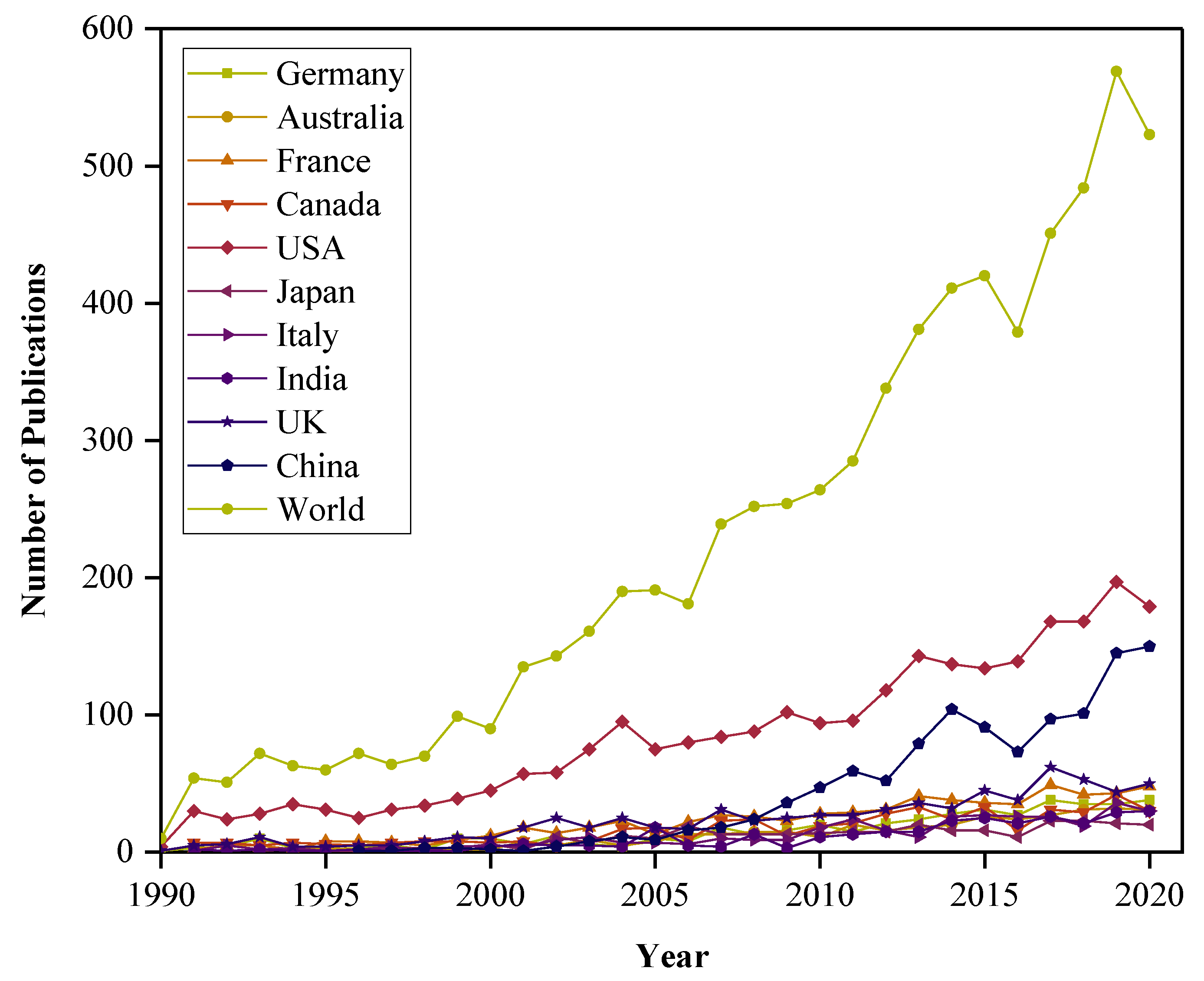


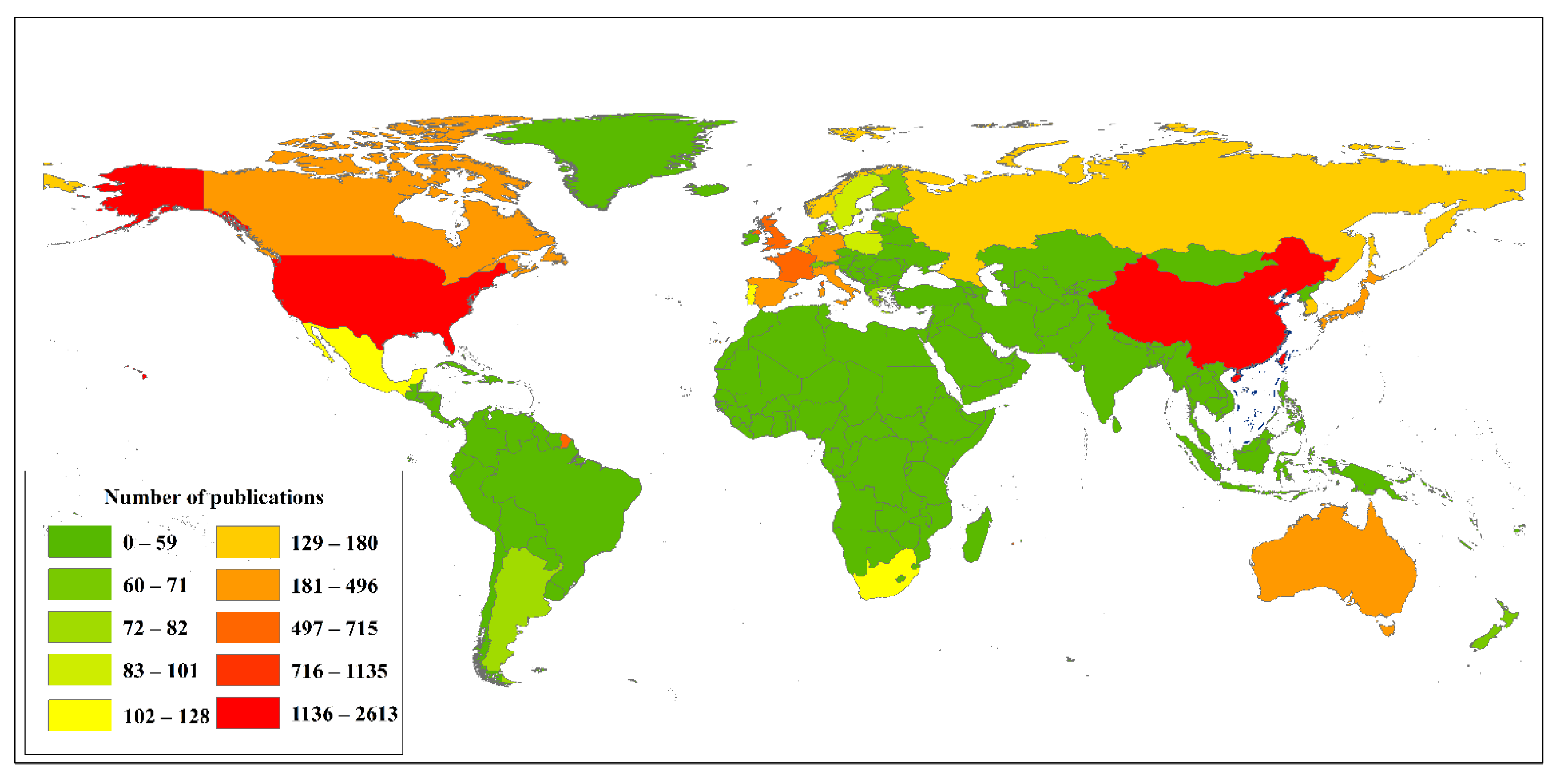

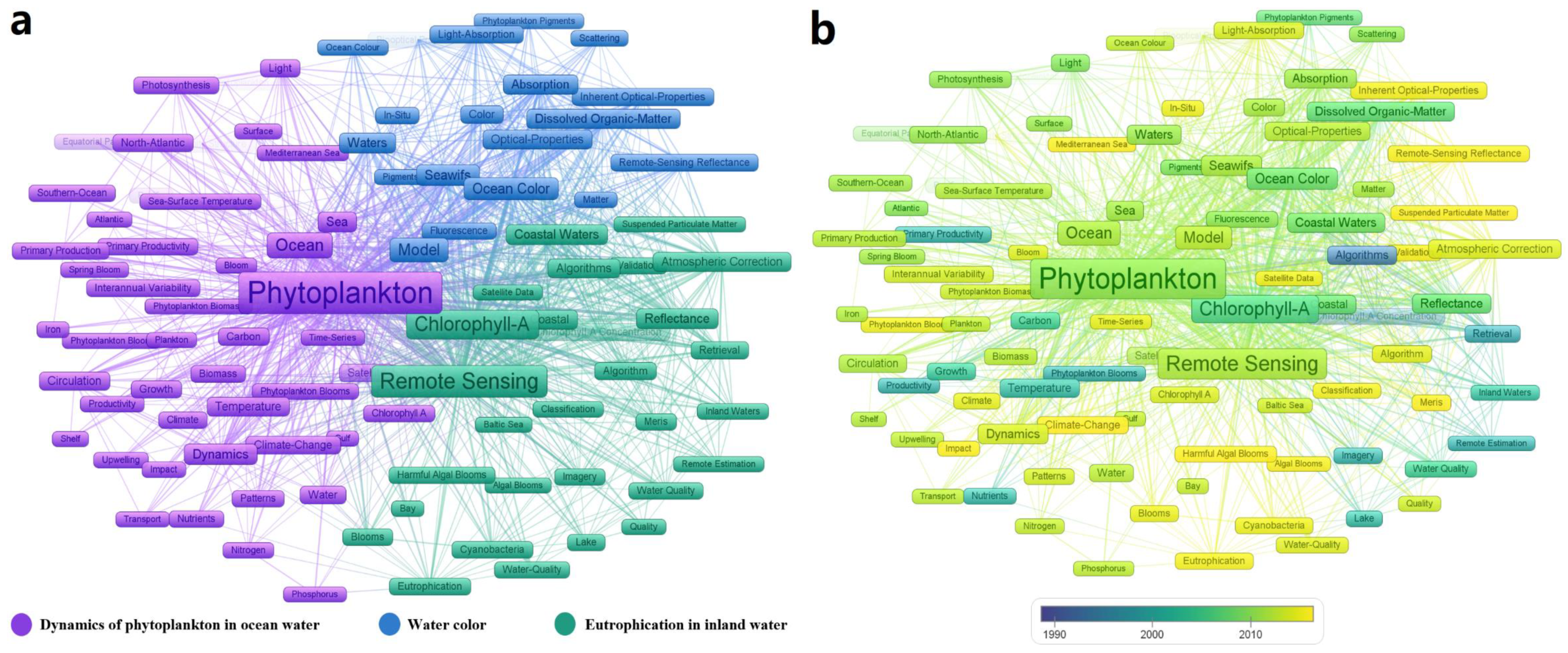
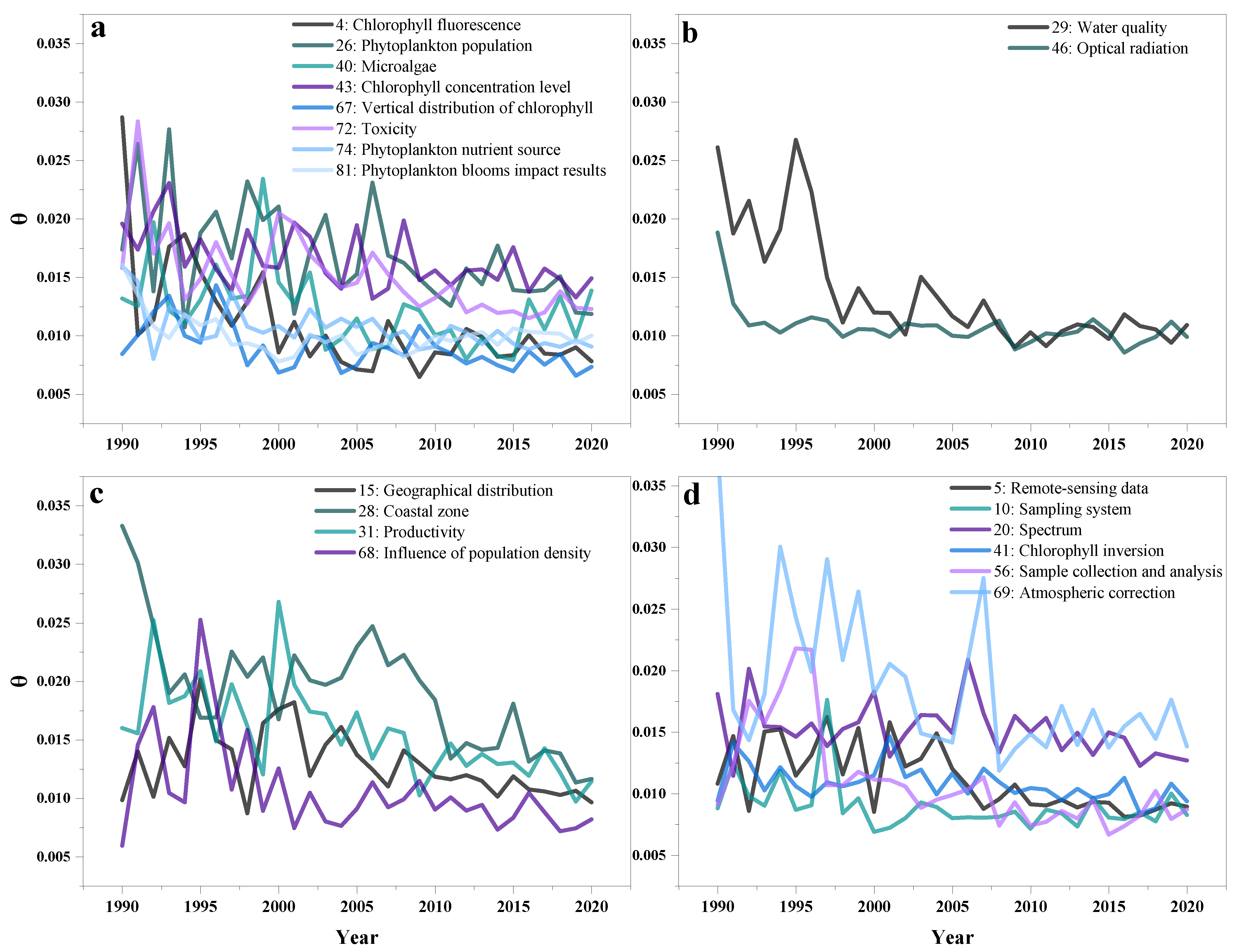
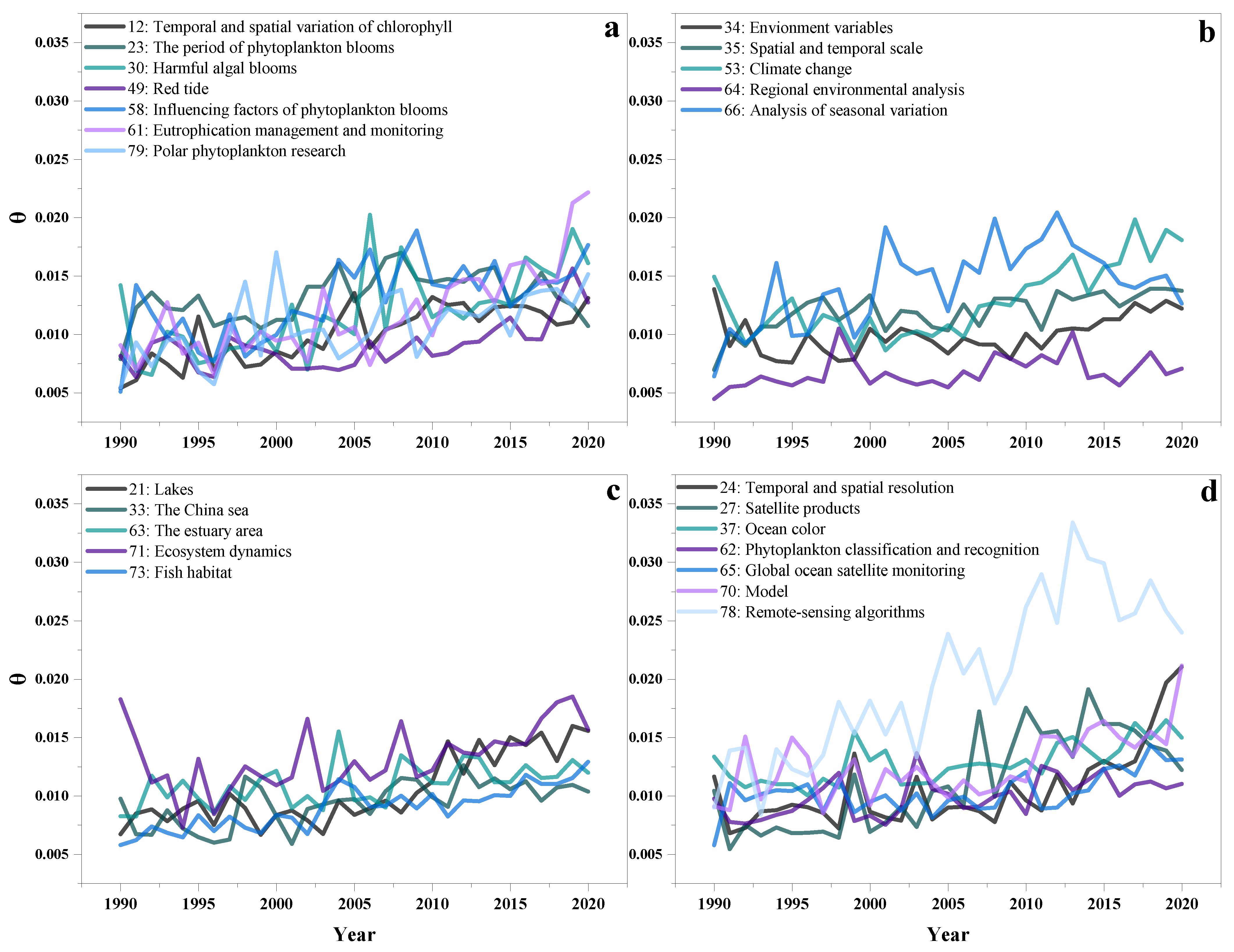
| Discipline | Total Number of Articles | Percentage |
|---|---|---|
| Oceanography | 2384 | 34.273 |
| Environmental Sciences | 2079 | 29.888 |
| Remote Sensing | 1540 | 22.139 |
| Imaging Science Photographic Technology | 1415 | 20.342 |
| Marine Freshwater Biology | 1378 | 19.81 |
| Geosciences Multidisciplinary | 1338 | 19.235 |
| Ecology | 588 | 8.453 |
| Limnology | 365 | 5.247 |
| Meteorology Atmospheric Sciences | 344 | 4.945 |
| Optics | 279 | 4.011 |
| Journal | Impact Factor in 2020 | Total Number of Articles | Percentage |
|---|---|---|---|
| Remote Sensing of Environment | 10.164 | 490 | 7.044 |
| Journal of Geophysical Research: Oceans | 3.405 | 486 | 6.987 |
| International Journal of Remote Sensing | 3.151 | 412 | 5.923 |
| Remote Sensing | 4.848 | 341 | 4.902 |
| Deep Sea Research Part II: Topical Studies in Oceanography | 2.732 | 215 | 3.091 |
| Journal of Marine Systems | 2.542 | 193 | 2.775 |
| Geophysical Research Letters | 4.72 | 191 | 2.746 |
| Continental Shelf Research | 2.391 | 171 | 2.458 |
| Marine Ecology Progress Series | 2.824 | 149 | 2.142 |
| Applied Optics | 1.98 | 134 | 1.926 |
| Organization | Country | Total Number of Articles | Percentage |
|---|---|---|---|
| Chinese Academy of Sciences | China | 542 | 7.792 |
| University of California | USA | 442 | 6.354 |
| CNRS | France | 440 | 6.325 |
| NOAA | USA | 374 | 5.377 |
| NASA | USA | 349 | 5.017 |
| Plymouth Marine Laboratory | UK | 310 | 4.457 |
| State University System of Florida | USA | 285 | 4.097 |
| Sorbonne University | France | 274 | 3.939 |
| NASA Goddard Space Flight Center | USA | 239 | 3.436 |
| Helmholtz Association | Germany | 227 | 3.263 |
| Algal (Chlorophyll) Changes | Temporal–Spatial and Environmental Factors | Biological and Geographic Factors | Remote Sensing and Methods |
|---|---|---|---|
| 2: Phytoplankton structures | 6: Particulate matter | 1: Impact on humans | 5: Remote-sensing data |
| 4: Chlorophyll fluorescence | 8: Phytoplankton seasonal characteristics | 3: Bay area | 10: Sampling system |
| 12: Temporal and spatial variation of chlorophyll | 14: Surface temperature | 9: Marine and ocean space | 17: Remote-sensing method |
| 23: The period of phytoplankton blooms | 29: Water quality | 11: Benthonic animal | 19: Optical properties |
| 26: Phytoplankton population | 34: Environment variables | 5: Geographical distribution | 20: Spectrum |
| 30: Harmful algal blooms | 35: Spatial and temporal scale | 18: Polar regions | 24: Temporal and spatial resolution |
| 40: Microalgae | 44: Aquatic environment | 21: Lakes | 27: Satellite products |
| 42: Ocean chlorophyll observation | 50: Particle absorption | 28: Coastal zone | 32: Remote-sensing observed results |
| 43: Chlorophyll concentration level | 51: Time series | 31: Productivity | 36: Development of remote-sensing technology |
| 48: Phytoplankton changes | 53: Climate change | 33: The China sea | 37: Ocean color |
| 49: Red tide | 55: Carbon dioxide change | 59: Intertidal zone | 38: Correlation analysis |
| 57: Eutrophication | 64: Regional environmental analysis | 63: The estuary area | 41: Chlorophyll inversion |
| 58: Influencing factors of phytoplankton blooms | 66: Analysis of seasonal variation | 68: Influence of population density | 45: Water quality monitoring |
| 61: Eutrophication management and monitoring | 82: Aerosol | 71: Ecosystem dynamics | 56: Sample collection and analysis |
| 67: Vertical distribution of chlorophyll | 73: Fish habitat | 60: Satellite in situ measurement | |
| 72: Toxicity | 62: Phytoplankton classification and recognition | ||
| 74: Phytoplankton nutrient source | 65: Global ocean satellite monitoring | ||
| 79: Polar phytoplankton research | 69: Atmospheric correction70: Model | ||
| 81: Phytoplankton blooms impact results | 78: Remote-sensing algorithms |
| Topic | p = 0.05 | p = 0.01 | p = 0.001 | p = 0.0001 |
|---|---|---|---|---|
| Significant linear increase | 25 | 23 | 20 | 15 |
| Significant linear decrease | 22 | 17 | 9 | 7 |
Publisher’s Note: MDPI stays neutral with regard to jurisdictional claims in published maps and institutional affiliations. |
© 2021 by the authors. Licensee MDPI, Basel, Switzerland. This article is an open access article distributed under the terms and conditions of the Creative Commons Attribution (CC BY) license (https://creativecommons.org/licenses/by/4.0/).
Share and Cite
Li, Y.; Zhou, Q.; Zhang, Y.; Li, J.; Shi, K. Research Trends in the Remote Sensing of Phytoplankton Blooms: Results from Bibliometrics. Remote Sens. 2021, 13, 4414. https://doi.org/10.3390/rs13214414
Li Y, Zhou Q, Zhang Y, Li J, Shi K. Research Trends in the Remote Sensing of Phytoplankton Blooms: Results from Bibliometrics. Remote Sensing. 2021; 13(21):4414. https://doi.org/10.3390/rs13214414
Chicago/Turabian StyleLi, Yuanrui, Qichao Zhou, Yun Zhang, Jingyi Li, and Kun Shi. 2021. "Research Trends in the Remote Sensing of Phytoplankton Blooms: Results from Bibliometrics" Remote Sensing 13, no. 21: 4414. https://doi.org/10.3390/rs13214414
APA StyleLi, Y., Zhou, Q., Zhang, Y., Li, J., & Shi, K. (2021). Research Trends in the Remote Sensing of Phytoplankton Blooms: Results from Bibliometrics. Remote Sensing, 13(21), 4414. https://doi.org/10.3390/rs13214414








